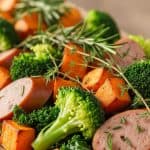There’s an old kitchen saying: If you’re poking at sausage, you’re probably worried it’s not done. For chicken sausage, this worry is justified. Undercooked poultry isn’t just unpleasant, it can make you sick. But overcooked sausage is dry, crumbly, and a waste of good meat. So, when is chicken sausage done? The answer is both technical and tactile, a blend of thermometer readings, visual clues, and a bit of patience.
Key Takeaways
- Always check the internal temperature. 165°F (74°C) is a must.
- Look for golden brown skin and any clear juices. No pink inside.
- Let sausage rest a few minutes after cooking. It helps keep the juices in.
Understanding When Chicken Sausage is Done

- Visual Cue: Golden brown skin means the sausage has been heated properly.
- Texture Test: Press gently, if it feels firm and springy, you’re probably good.
- Juices: If the juices run clear when you pierce it, it’s likely cooked.
- No Pink: When sliced, the inside should be opaque with no raw spots.
Importance of Internal Temperature
Let’s get technical for a second. Ground poultry is more susceptible to bacteria than whole cuts because everything, surface and interior, mixes together during grinding. That’s why the safe temp for chicken sausage is higher than for steak or even pork.
- Safe Minimum Temperature: 165°F (74°C). This is the bacteria kill temp for ground chicken.[1]
- Carryover Cooking: If you pull sausage at 160°F and let it rest, carryover heat may bring it up to 165°F. But for cautious cooks, aim for 165°F in the thickest part and then rest.
- Use a Digital Thermometer: Instant-read models are best. Probe the center of the thickest link. Don’t just poke the end.
Using a Meat Thermometer Properly
You might think sticking a thermometer in sausage is overkill. The pros do it every day. Here’s how:
- Insert probe into thickest part, don’t touch the pan or grill.
- Wait for a steady reading, this usually takes a few seconds.
- Check each link in a batch if sizes vary.
If you’re not using a thermometer, you’re flying blind. There’s no reliable visual shortcut, especially for chicken.
Visual and Texture Indicators
Still, not everyone wants to fuss with gadgets. There are old-school signs you can watch for, though they aren’t foolproof:
- Golden Brown Exterior: Proper browning means the pan or oven is hot enough.
- Firm Texture: Press gently, done sausage feels springy, not squishy.
- Juices Running Clear: Pierce the sausage; clear liquid means cooked, but some seasoned sausages may have a little color.
- No Pink Inside: Slice the thickest sausage, look for opaque meat with no raw pink. (Note: some sausages with lots of herbs or smoked spices can look slightly pink when safe.)
If in doubt, fall back to the thermometer.
Cooking Methods and Times to Achieve Doneness

Credit: Mike Brown BBQ
Chicken sausage doesn’t care if you’re an oven loyalist, a grill devotee, or a pan-frying purist. Each method has its own quirks and timeframes. Here’s what works:
Oven Cooking
- Temperature: 375°F (190°C)
- Time: 20–25 minutes for raw sausages, depending on thickness
- Tips: Don’t crowd the tray. Flip halfway for even browning.
Stovetop
- Heat: Medium, with a splash of oil
- Time: 8–12 minutes
- Action: Turn every 2–3 minutes for browning all around
Grilling
- Flame: Medium
- Time: 20–25 minutes
- Move: Roll sausages often, especially over hot spots
Broiling
- Distance: 7–9 inches from the heat source
- Time: 13–15 minutes per side
- Note: Watch closely to avoid burning
Air Fryer
- Temp: 375°F–400°F (190°C–200°C)
- Time: 15–20 minutes, depending on size
- Trick: Don’t stack, give each sausage space
No matter the method, always check internal temp.
Best Practices for Ensuring Chicken Sausage is Done
- Flip regularly: This ensures even cooking.
- Don’t overcrowd: Leaving space helps things cook evenly.
- Let them rest: After cooking, let them sit for about 3-5 minutes. This keeps them juicy.
- Hygiene is key: Clean hands and surfaces after dealing with raw chicken.[2]
Hygiene and Safety When Handling Raw Sausage
Chicken sausage is less forgiving than pork or beef. Follow basic food safety:
- Wash hands before and after touching raw sausage.
- Clean all surfaces, cutting boards, and knives.
- Don’t reuse plates or tongs used for raw sausage.
- Store cooked sausage in the fridge within two hours (one hour if over 90°F in your kitchen).
Additional Tips and Recommendations
Enhancing Flavor and Texture
- Browning adds flavor. High heat at the end gives you a crisp, tasty skin.
- Resting retains moisture. Always let sausage sit before slicing or serving.
- Pair thoughtfully. Chicken sausage goes well with roasted vegetables, grain salads, or even simple mustard and kraut.
Selecting Quality Sausage for Best Results
- Pick sausages with a firm, springy texture, avoid mushy links.
- Check ingredient lists for balanced spices and minimal fillers.
- Local butchers often offer fresher options with better flavor.
Common Mistakes
- Overcooking: Can make the sausage dry. Stop at 165°F.
- High heat: This can burst casings. Stick to medium heat mostly.
- Guessing doneness: Always use a thermometer for accuracy.
Practical Advice for Enthusiasts
If you want every batch of chicken sausage to turn out juicy, flavorful, and safe, buy a good digital instant-read thermometer. Test your sausages at the thickest point. Trust the temp, not your eyes. Let them rest. Don’t crowd the pan or tray. Remember, 165°F is the line between great sausage and taking a gamble.Next time you’re poking at sausage, you’ll know exactly what to do, and you’ll never have to wonder if it’s done. That’s real kitchen confidence.Ready to try? Pick your favorite method and cook up a batch tonight, just keep the thermometer handy. Happy sausage grilling, baking, frying, or air frying.
FAQ
How do I know when chicken sausage is done cooking?
To tell when chicken sausage is done, check for an internal temperature chicken sausage reading of 165°F. That’s the safe temp for chicken sausage according to USDA chicken sausage temp guidelines. A chicken sausage thermometer reading with an instant read thermometer sausage probe should be taken at the thickest part. Don’t go by color alone, chicken sausage pink inside can be normal. Use a chicken sausage doneness indicator like clear juice or firm texture. Cook chicken sausage to 165°F and let it rest so carryover cooking chicken sausage can finish the job safely.
Is a little pink inside chicken sausage okay?
Sometimes, chicken sausage pink inside doesn’t mean it’s undercooked. The best way to check is with a thermometer. Chicken sausage’s safe internal temp is 165°F, which kills bacteria like salmonella chicken sausage. Look for clear chicken sausage juice and a firm texture. A calibrated chicken sausage digital thermometer helps. Remember, a chicken sausage color test can be tricky, so rely on a chicken sausage thermometer reading instead.
What is the best way to check doneness without a thermometer?
If you don’t have a thermometer, check for clear juices chicken sausage, firm texture, and use the poke test for sausage doneness. Still, a thermometer is the safest method, cooking sausage safe min temp is 165°F. Without tools, chicken sausage done without a thermometer is risky. Use visual cues like the chicken sausage splitting casing test or skin tension test sausage, but know these aren’t perfect. Internal heat distribution varies, so always try to cook chicken sausage evenly.
Does chicken sausage keep cooking after it’s off the heat?
Yes. That’s called carryover cooking chicken sausage. Once you pull it from the heat at about 160°F, it can rise to the safe temp for chicken sausage, 165°F, during the chicken sausage rest time. This helps with chicken sausage moisture retention and preventing dryness sausage. Letting it sit allows juices to settle and chicken sausage internal heat distribution to even out. Carry‑over heat sausage helps finish the job, especially for thicker links.
Is there a difference between grilling and baking chicken sausage?
Grilled vs baked chicken sausage doneness depends on the method and heat. Grill chicken sausage doneness might show a crisp casing faster, but the inside still needs to reach 165°F. Bake chicken sausage doneness takes longer but offers more even chicken sausage internal heat distribution. No matter the method, use a chicken sausage temperature probe insertion into the thickest part. Chicken sausage cooking methods comparison shows all styles work, as long as the chicken sausage temperature range stays within the safe zone.
Can I eat medium rare chicken sausage if it’s juicy?
No. Chicken sausage medium rare is not safe. Juiciness doesn’t mean it’s done. Chicken sausage safe to eat needs a chicken sausage internal temp of 165°F. That’s when the chicken sausage bacteria kill temp is reached, making it safe from foodborne risks. Don’t risk chicken sausage food safety, check with a chicken sausage thermometer reading, even if the sausage looks great or has a juicy centre temp that feels “right.”
How does freezing affect cooking time and doneness?
Frozen chicken sausage cook time is longer than thawed. It’s harder to reach chicken sausage thickest part temp quickly, which affects doneness. To speed things up and ensure even cooking, let it reach room temp sausage before cooking. Chicken sausage thawed cooking time is more reliable. Whether you’re boiling chicken sausage doneness or using an air fryer chicken sausage temperature setting, always make sure the inside hits 165°F.
What happens if I overcook chicken sausage?
Overcooking dries it out. Chicken sausage fat rendering too much can ruin the texture. Use a chicken sausage doneness chart and follow chicken sausage cooking guidelines to avoid this. Going above the chicken sausage’s best internal temp or max safe temp kills flavor and makes it rubbery. Watch for the chicken sausage overcooking indicator: shriveled casing, dry center, no juice. For flavorful chicken sausage cooking temp, stop at 165°F and let it rest.
What’s the safest way to test chicken sausage doneness?
Use a calibrated thermometer. Instant read thermometer sausage tools should be checked using calibration thermometer chicken sausage methods. Insert the probe into the thickest part for the most accurate chicken sausage testing temp. This avoids guessing based on color or texture alone. Following FSIS chicken sausage guidelines and using the cook sausage to temperature chart helps reduce risks. For professionals, chicken sausage expert guidelines recommend checking doneness halfway through cooking, especially for unevenly shaped links.
Why does my sausage look done outside but not inside?
That’s because the chicken sausage crispy outside temp can be reached before the inside cooks through. To fix that, focus on chicken sausage internal heat distribution. Always test the thickest part temp. Chicken sausage cooking difficulties like pockets of heat or high fat content affect temp accuracy. Using proper chicken sausage cooking technique temp, lower heat for a longer time helps. Don’t let the crispy skin fool you, use your chicken sausage digital thermometer.
References
- http://www.fsis.usda.gov/food-safety/safe-food-handling-and-preparation/meat-catfish/sausages-and-food-safety#:~:text=To%20prevent%20foodborne%20illness%2C%20uncooked,cooked%20to%20165%20degrees%20F.
- .https://shoplogans.com/blogs/news/chicken-sausage-101-what-it-is-how-to-prepare-it?srsltid=AfmBOoqMVH3AE1jdlgEJvanVYM8PRiA6ihF8106ih5x4TNN7HSkAQVgo
Related Articles
- https://milkwoodrestaurant.com/how-to-know-when-chicken-sausage-is-done/
- https://milkwoodrestaurant.com/how-to-cook-chicken-sausage-at-home/
- https://milkwoodrestaurant.com/how-long-to-cook-chicken-sausage-in-oven-at-425/
Was this helpful?

I’m Mary R. Q. , a seasoned professional chef dedicated to elevating home cooking experiences. Through my expertise in the culinary arts, I provide practical cooking tips and insightful reviews of kitchen utensils on my blog, milkwoodrestaurant.com. As a passionate advocate for transforming everyday meals into extraordinary culinary adventures, I aim to empower home cooks with the knowledge and tools they need to create delicious and memorable dishes. I’m also an author of the book “1,001 Kitchen Tips & Tricks: Helpful Hints for Cooking, Baking, and Cleaning (1,001 Tips & Tricks)” which is sold on Amazon. Join me on a flavorful journey as we explore the art of cooking and the essential tools that make it a joy.








